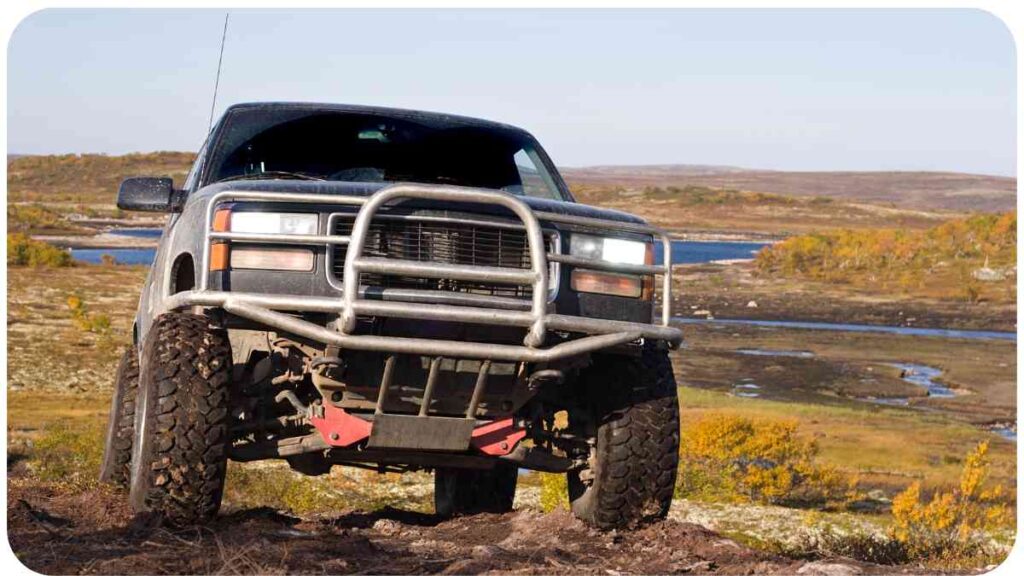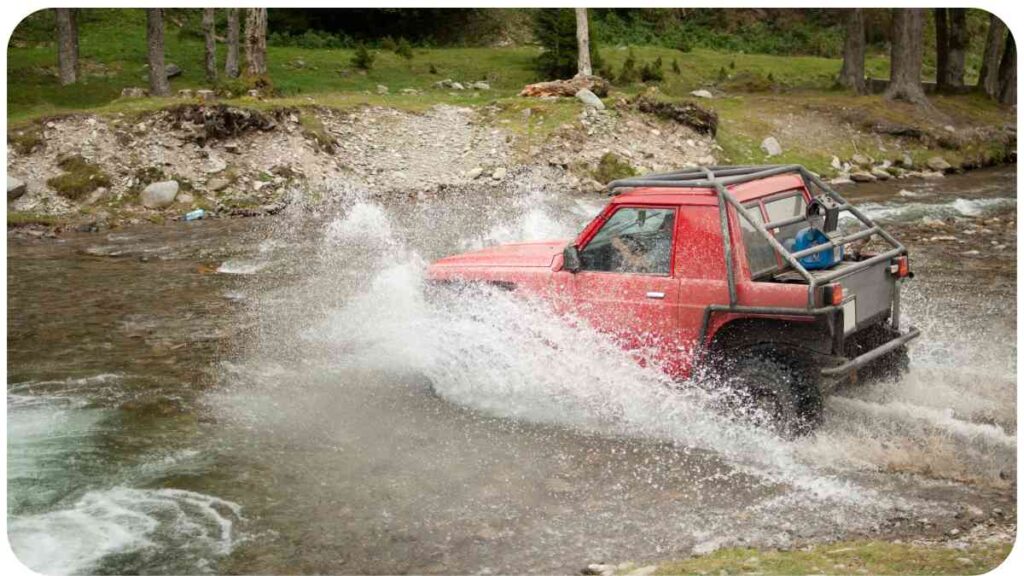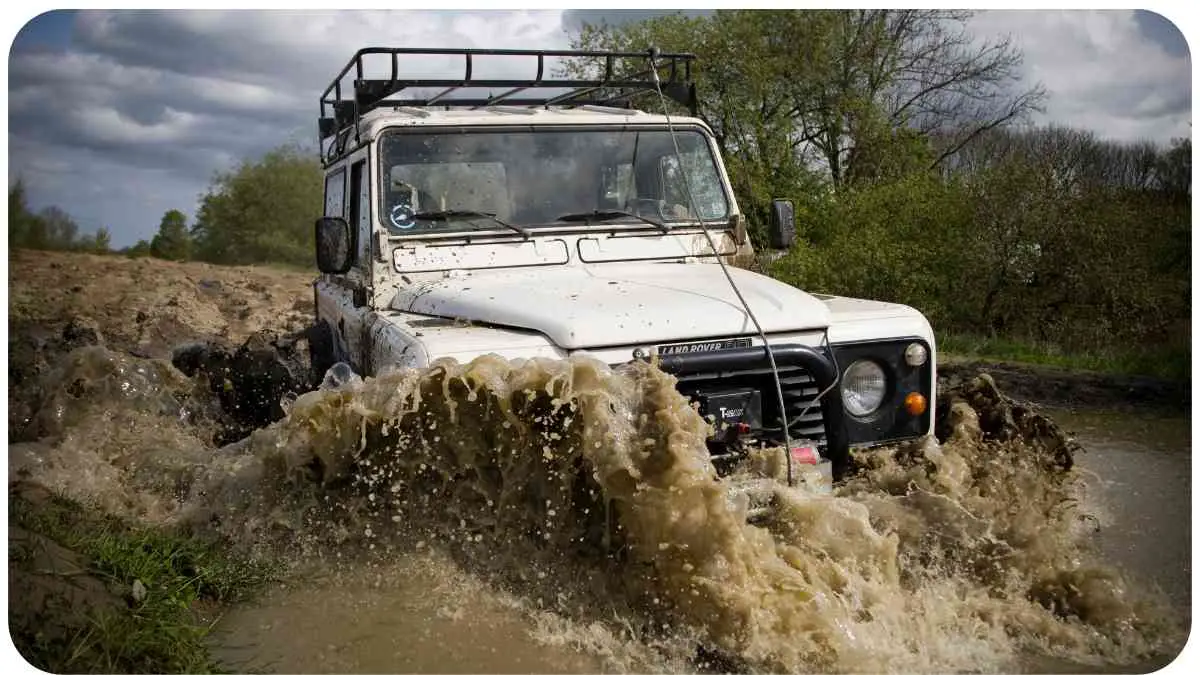Welcome to the comprehensive guide on off-road driving techniques! Whether you’re an experienced off-roader seeking to refine your skills or a beginner fascinated by the world of off-roading, this guide will provide valuable insights and tips to elevate your off-road adventures. Off-roading offers a thrilling and captivating experience, but it is crucial to approach it with the right knowledge and techniques to ensure safety and enjoyment.
In this guide, we will delve into various aspects of off-road driving, covering everything from choosing the right vehicle to mastering advanced techniques. We’ll also discuss the importance of safety, environmental responsibility, and vehicle maintenance to maximize your off-roading experience. So, buckle up and get ready for an exciting journey!
| Takeaways |
|---|
| When off-roading, it’s important to practice responsible driving by staying on designated trails and minimizing your impact on the environment. |
| Maintaining your off-road vehicle is crucial for its reliability and optimal performance. Regular servicing, inspections, and cleaning are essential. |
| Safety should always be a priority when off-roading. Use appropriate safety equipment, stay within your vehicle’s limits, and travel in groups for support. |
| Developing and mastering off-road driving techniques will enhance your experience and allow you to tackle different terrain types with confidence. |
| Enjoy the thrill of off-roading while respecting wildlife, natural habitats, and fellow off-roaders. Engage with the off-roading community and share your experiences. |
2. Understanding Off-Roading
What is off-roading?
Off-roading refers to the act of driving a vehicle on unpaved or rough terrain, away from traditional roads. It involves exploring natural landscapes, challenging obstacles, and thrilling adventures. Off-roading can take place in various environments, such as forests, deserts, mountains, or even snowy landscapes. It offers a unique opportunity to connect with nature and push the limits of both driver and vehicle.
The appeal of off-roading
People are drawn to off-roading for various reasons. The thrill of tackling challenging obstacles, the opportunity to explore remote and breathtaking locations, and the sense of adventure and freedom it provides are just a few reasons why off-roading has gained popularity. Additionally, the off-roading community offers a sense of camaraderie, with enthusiasts sharing their experiences, tips, and tricks to help one another.
The importance of safety
While off-roading offers excitement and adventure, safety should always remain a top priority. Off-road driving comes with its own set of risks and challenges. It is crucial to be well-prepared, knowledgeable, and equipped with the necessary skills and gear to ensure a safe off-roading experience. By adhering to proper safety measures, individuals can mitigate risks and fully enjoy the thrill of off-roading.
3. Choosing the Right Vehicle

When it comes to off-roading, selecting the right vehicle is essential. Consider the following factors to make an informed decision:
Factors to consider in selecting a vehicle
- Terrain: Assess the type of terrain you intend to conquer. Different vehicles excel in specific environments, be it mud, sand, or rocky terrains. Choose a vehicle that suits your intended off-roading adventures.
- Size and Maneuverability: Depending on the trails you plan to explore, consider the size and maneuverability of the vehicle. Smaller vehicles tend to navigate tight spaces better, while larger ones may offer increased stability.
- Ground Clearance and Suspension: Off-road vehicles require sufficient ground clearance to overcome obstacles. Look for vehicles with a high clearance and durable suspension systems to handle rough terrains.
- Four-Wheel Drive (4WD): Opt for a vehicle equipped with 4WD, as it provides improved traction and power distribution to all wheels. This feature is crucial for tackling challenging off-road conditions.
Popular off-road vehicle brands and models
| Brand | Models |
| Jeep | Wrangler, Grand Cherokee |
| Toyota | Land Cruiser, 4Runner |
| Ford | F-150 Raptor, Bronco |
| Chevrolet | Colorado ZR2, Silverado |
| Land Rover | Defender, Range Rover |
| Mercedes-Benz | G-Class, GLS-Class |
| Nissan | Patrol, Frontier |
These brands and models are widely recognized for their off-road capabilities and are trusted by off-roading enthusiasts globally.
4. Essential Off-Road Driving Skills
To navigate off-road trails with confidence and maximize your vehicle’s potential, it is crucial to develop and hone essential off-road driving skills. Let’s explore a few key skills:
Proper body positioning
Maintaining the correct body positioning is crucial to maintain vehicle balance and stability during off-road driving. As the terrain becomes uneven or challenging, it’s essential to adjust your body position accordingly. Lean back slightly to allow the vehicle’s suspension to handle bumps and maximize traction on all wheels.
Tire selection and maintenance
Choosing the right tires for off-roading is paramount. Look for off-road tires with aggressive tread patterns to enhance traction on different terrains. Regularly inspect and maintain tire pressure, ensuring it aligns with the manufacturer’s recommendations. Proper tire maintenance contributes to vehicle stability and improves overall off-road performance.
Effective use of 4WD and differential locks
Understanding how to utilize your vehicle’s 4WD system is crucial for off-road driving. Engaging 4WD when facing challenging conditions such as deep mud or loose sand allows power to be distributed to all wheels, increasing traction. Additionally, some vehicles come equipped with differential locks, which provide optimal power distribution to prevent wheelspin on tricky terrain.
5. Navigating Different Terrain Types
Off-roading encounters a wide range of terrains, each requiring specific techniques for a successful traversal. Let’s explore some common terrain types and the techniques used to navigate through them:
Mud and slush
Muddy trails pose unique challenges due to the decreased traction and increased risk of getting stuck. Maintain steady momentum while avoiding sudden acceleration, which can cause wheelspin. Reduce tire pressure to improve traction and prevent the tires from digging into the mud. Utilize the vehicle’s 4WD system to distribute power evenly, allowing the tires to grip the terrain.
Sand dunes
When tackling sandy terrains, maintaining momentum is essential. Reduce tire pressure to increase the tire’s footprint and prevent sinking. Gradually increase speed while maintaining control to avoid getting stuck. Make smooth turns and avoid sudden braking, which can cause the vehicle to dig into the sand. It’s crucial to follow designated tracks and be mindful of potential wildlife habitats.
Rocky terrain
Navigating rocky terrain requires constant vigilance and precise maneuvering. Approach rocky obstacles at a controlled speed, allowing the vehicle’s suspension to absorb impact. Choose the best line of travel to avoid scraping the undercarriage on protruding rocks. Use higher ground clearance and engage the differential locks when faced with challenging uphill or downhill sections. Maintaining traction and vehicle balance is key.
Uneven trails
Uneven trails may consist of varying surfaces, including loose gravel, ruts, and small obstacles. Always maintain a slow and consistent speed, allowing the vehicle to adjust to the changing terrain. Engage low-range gears and use proper body positioning to increase stability. Gradually navigate through obstacles, avoiding sudden movements. Keep an eye out for hidden obstacles and choose the smoothest path available.
6. Implementing Advanced Techniques
To conquer more advanced off-road challenges, it’s essential to master additional techniques. Let’s explore some advanced techniques that can come in handy during extreme situations:
Ascending and descending steep slopes
When ascending steep slopes, maintain an even speed and avoid sudden acceleration to prevent wheel spin. Lean forward slightly to transfer weight to the front wheels, improving traction. On steep descents, descend in a low gear with the vehicle in control. Utilize engine braking to maintain a controlled speed and avoid overheating the brakes. Keep both hands on the steering wheel and maintain focus during the ascent or descent.
Crossing water obstacles

Crossing water obstacles requires caution and preparation. Assess the depth and condition of the water before proceeding. Engage the appropriate gear, typically low range with higher RPM, to prevent water from entering the exhaust or transmission. Maintain a slow and steady pace to create a bow wave, minimizing water splashes and ensuring the engine’s air intake remains above water level. Always check for potential unseen obstacles beneath the water’s surface.
Handling side slopes
When traversing side slopes, maintain a slow and controlled speed. Tilt the vehicle slightly toward the slope to maintain stability and maximize tire traction. Ensure that all passengers are seated on the uphill side of the vehicle to maintain weight distribution. Avoid abrupt steering or throttle inputs, as they can cause the vehicle to roll over. If necessary, use recovery equipment such as winches or snatch straps to stabilize the vehicle.
Recovering from extreme situations
Even with careful planning, off-roading can sometimes lead to getting stuck or encountering difficult situations. Ensure you are equipped with recovery gear such as shackles, straps, a shovel, and a winch. Familiarize yourself with recovery techniques such as winching, using traction boards, or seeking assistance from fellow off-roaders. Remember to prioritize safety and approach recovery calmly.
7. Safety Precautions and Gear
Off-roading can be exhilarating, but it’s essential to prioritize safety. Protect yourself and others by following these safety precautions and ensuring you have the necessary gear:
Essential safety equipment
- Seatbelts: Always wear seatbelts to provide protection in case of sudden stops or accidents.
- Helmet: If engaging in extreme off-roading activities like rock crawling or racing, wearing a helmet is strongly recommended.
- Roll cage: Consider installing a roll cage in your vehicle to provide additional protection in the event of a rollover.
- First aid kit: Keep a well-stocked first aid kit readily available in case of injuries or emergencies.
- Fire extinguisher: Have a fire extinguisher rated for vehicle fires within reach in case of fire emergencies.
- Communication devices: Carry a reliable communication device like a two-way radio or satellite phone to stay connected in remote areas.
Understanding vehicle limits
Know the limitations of your vehicle and respect them. Off-roading pushes both driver and vehicle to their boundaries, so understanding the capabilities and limits of your vehicle is crucial for safety. Be aware of the maximum angle of approach, departure, and breakover angle your vehicle can handle to avoid damaging crucial components.
Traveling in groups
Off-roading with a group has several benefits, including safety. By traveling with fellow off-roaders, you have the support and assistance needed in case of emergencies, vehicle breakdowns, or recovery situations. Group members can provide guidance, share their experiences, and offer valuable advice when navigating challenging terrains.
8. Maintenance and Care for Off-Road Vehicles
Maintaining your off-road vehicle properly ensures its reliability, longevity, and optimal performance. Consider the following maintenance and care tips:
Regular servicing and inspections
Follow the manufacturer’s recommended maintenance schedule for regular servicing. This includes oil changes, air filter replacements, and general inspections. Regularly check and maintain fluid levels, ensuring everything is within the recommended range.
Cleaning and protecting the exterior
Off-road adventures often expose the vehicle to dirt, mud, and grime. Regularly clean the exterior to prevent buildup, which can cause damage or affect the vehicle’s performance. Apply protective coatings or wax to the paintwork to safeguard it from scratches and UV damage.
Safeguarding the suspension system
Your vehicle’s suspension system plays a vital role in off-road driving. Inspect and maintain the suspension components, including shocks, springs, and bushings. Regularly check for signs of wear and tear, and replace any damaged or worn-out parts promptly.
9. Environmental Responsibility
Off-roading allows us to explore and appreciate the beauty of nature, but it’s crucial to minimize the environmental impact. Practice responsible off-roading with these guidelines:
Leave no trace principles
- Plan ahead: Research and prepare before heading out, ensuring you understand the terrain and any applicable regulations.
- Stay on designated trails: Stick to established trails and avoid venturing into sensitive or protected areas. Respect any closure signs or guidelines.
- Minimize campfire impacts: If building a campfire, use designated fire rings or pits. Fully extinguish the fire before leaving the area.
- Dispose of waste responsibly: Pack out all your trash and dispose of it properly. Do not litter or leave any waste behind.
Respecting wildlife and natural habitats
- Observe wildlife from a distance: Respect wildlife by observing them from a distance, never approaching or disturbing them. Do not feed or interact with wild animals.
- Protect natural habitats: Avoid damaging vegetation, fragile ecosystems, or nesting sites. Stay on designated trails and minimize your impact on flora and fauna.
Minimizing impact on trails
- Avoid unnecessary trail widening: Drive only on existing trails and avoid creating new paths. Do not widen trails or create shortcuts that can lead to erosion.
- Practice responsible driving: Drive at a reasonable speed, avoiding excessive wheel spin or aggressive maneuvers that can damage trails.
- Clean your vehicle: After off-roading, clean your vehicle to prevent the spread of invasive plant species or diseases between different environments.
10. The Thrill of Off-Roading: Personal Experiences and Anecdotes
Off-road adventures offer unique experiences and unforgettable memories. Many off-roaders have exciting stories to share, from challenging obstacles conquered to breathtaking landscapes explored. Engage with the off-roading community, join forums or events, and share your own adventures and anecdotes. Learning from others’ experiences can enhance your knowledge and make off-roading even more enjoyable.
11. Conclusion
Off-road driving is a thrilling and rewarding activity that allows you to explore the world beyond traditional roads. By choosing the right vehicle, mastering essential off-road skills, practicing safety precautions and environmental responsibility, and maintaining your vehicle properly, you can embark on exciting off-road adventures while ensuring safety and preserving nature’s beauty. Enjoy the thrill, develop your skills, and create unforgettable memories as you explore the off-road world!
Further Reading
Here are some additional resources for further reading on off-road driving techniques:
- DrivingFast.net – Off-Road Driving Techniques: This website provides detailed information and tips on various off-road driving techniques, including tackling different terrains, handling obstacles, and advanced maneuvers.
- Off-road Driving Techniques by Nick Dimbleby: This book by Nick Dimbleby offers a comprehensive guide to off-road driving techniques, covering topics such as vehicle preparation, navigating different terrain types, and advanced driving skills.
- Ultimate Off-road Driver’s Guide by Vijay P. Bharti: Authored by Vijay P. Bharti, this book serves as a comprehensive resource for off-road enthusiasts, covering a wide range of topics including vehicle modifications, recovery techniques, and off-road navigation.
FAQs
Q: Are off-road vehicles suitable for daily use?
A: While off-road vehicles can be used for daily transportation, they are specifically designed for off-road adventures and may offer a less comfortable ride on regular roads compared to conventional vehicles.
Q: Can any vehicle be used for off-roading?
A: While some vehicles are better suited for off-roading due to their capabilities and features like higher ground clearance and 4WD, many vehicles can handle mild off-road conditions with proper technique and caution.
Q: What are the most common off-road modifications?
A: Common off-road modifications include installing larger and more aggressive tires, adding a lift kit for increased ground clearance, equipping a winch for recovery situations, and installing skid plates for protection against undercarriage damage.
Q: How do I recover a stuck vehicle during off-roading?
A: There are several recovery techniques, including using recovery straps or winches, employing traction boards or mats for traction, or seeking assistance from fellow off-roaders. It’s crucial to understand the proper use of equipment and follow safety precautions during recovery.
Q: Is off-roading dangerous?
A: Off-roading can pose certain risks and challenges. However, with proper preparation, following safety guidelines, and practicing responsible driving techniques, the risks can be minimized, and off-roading can be enjoyed safely.

Hi there! I’m Hellen James, and I’m the author of Unified Off-roads. I’ve been driving off-road for more than ten years, and I’ve had a lot of fun in that time—and a few not-so-great experiences too. But I’ve always wanted to help other people get started off-roading, so I decided to start this blog to share my knowledge with others.


